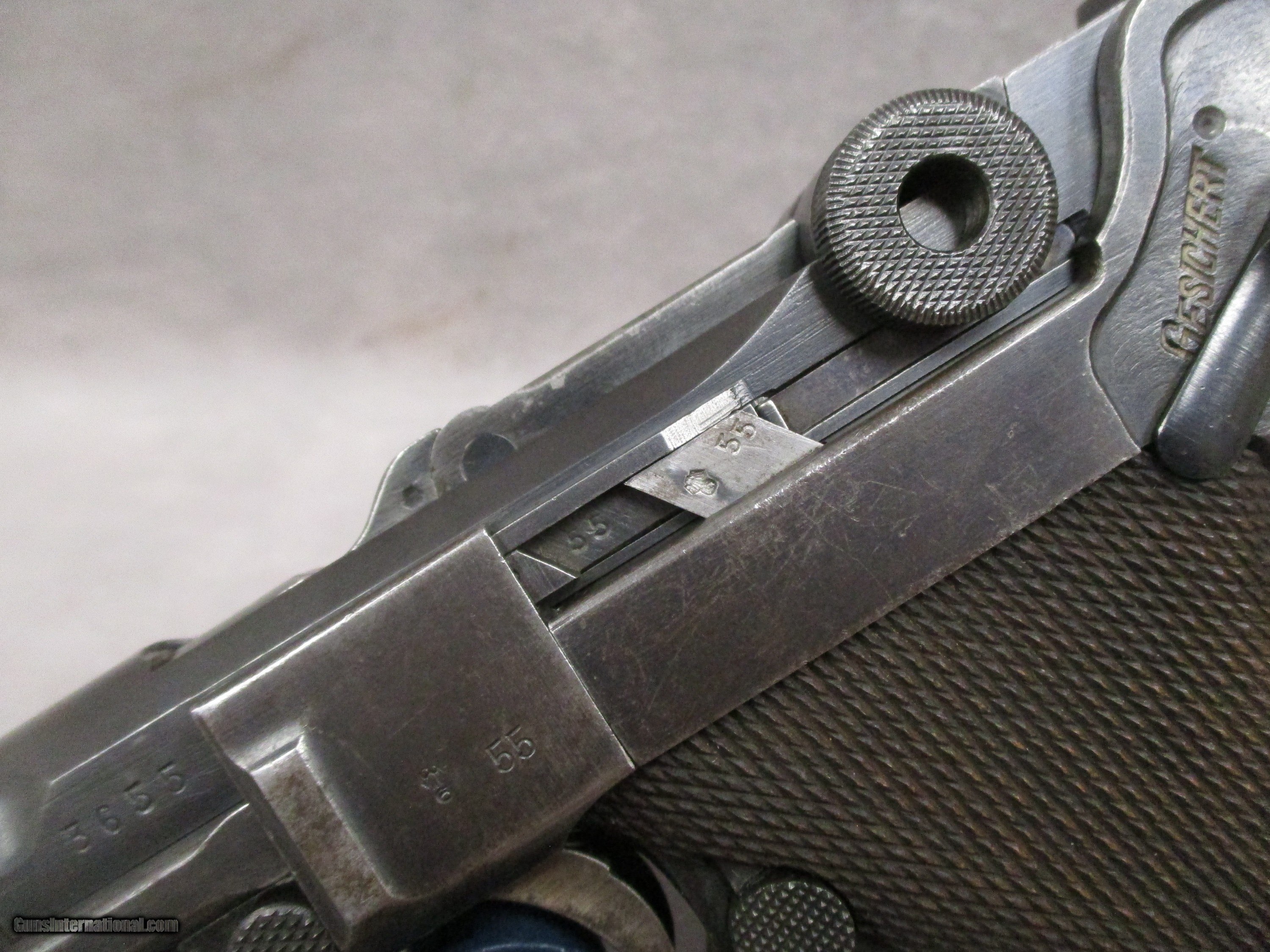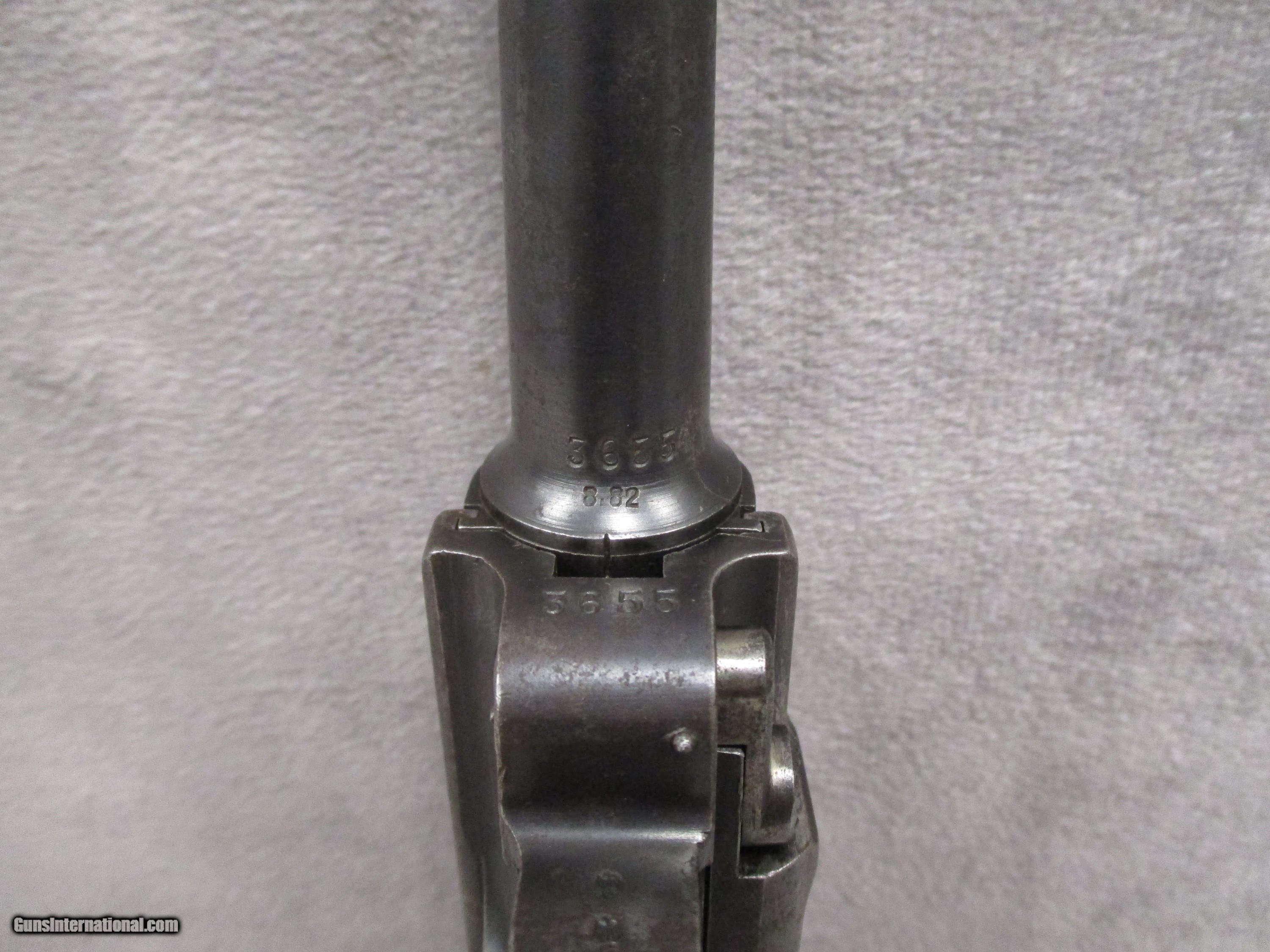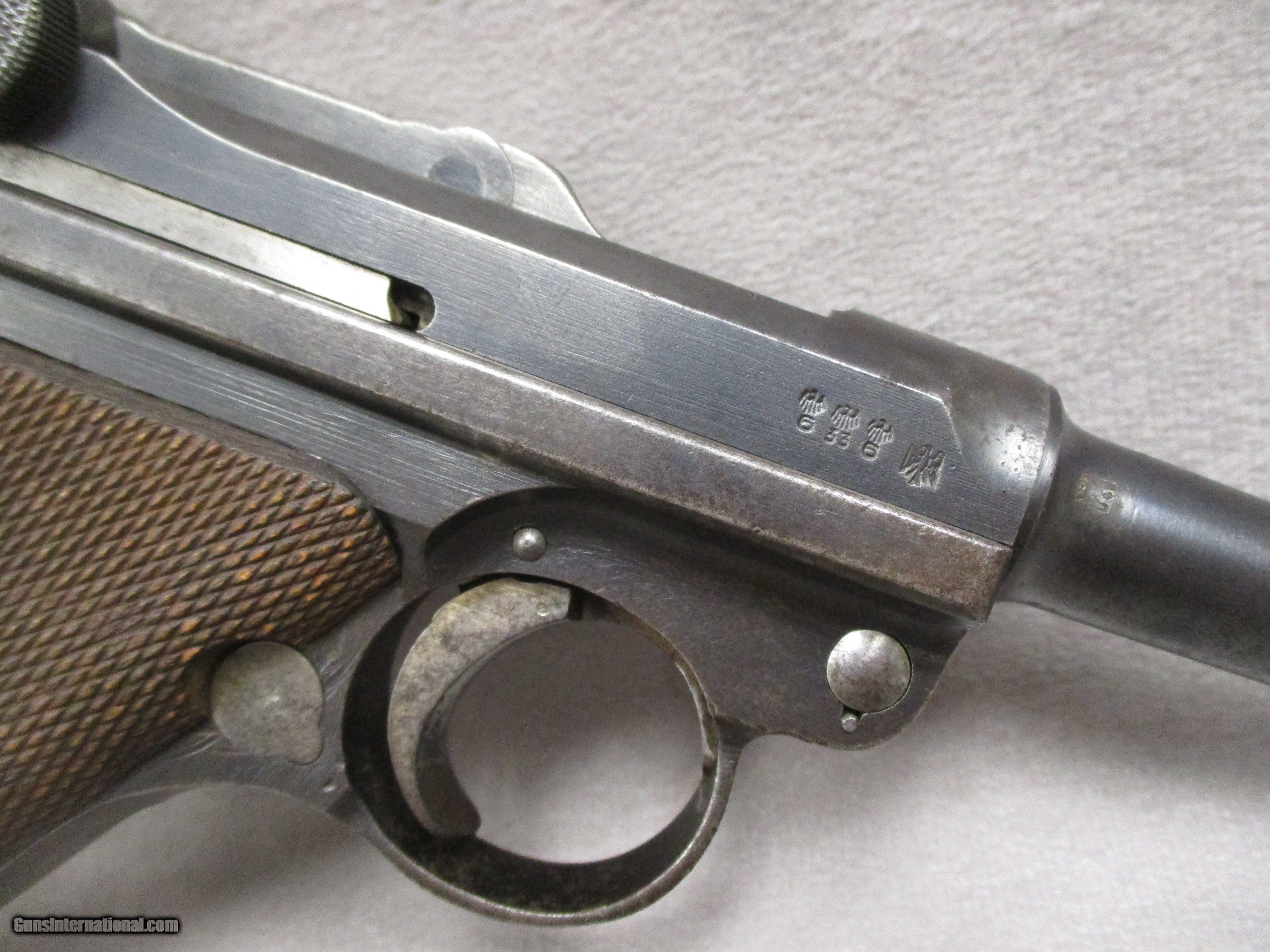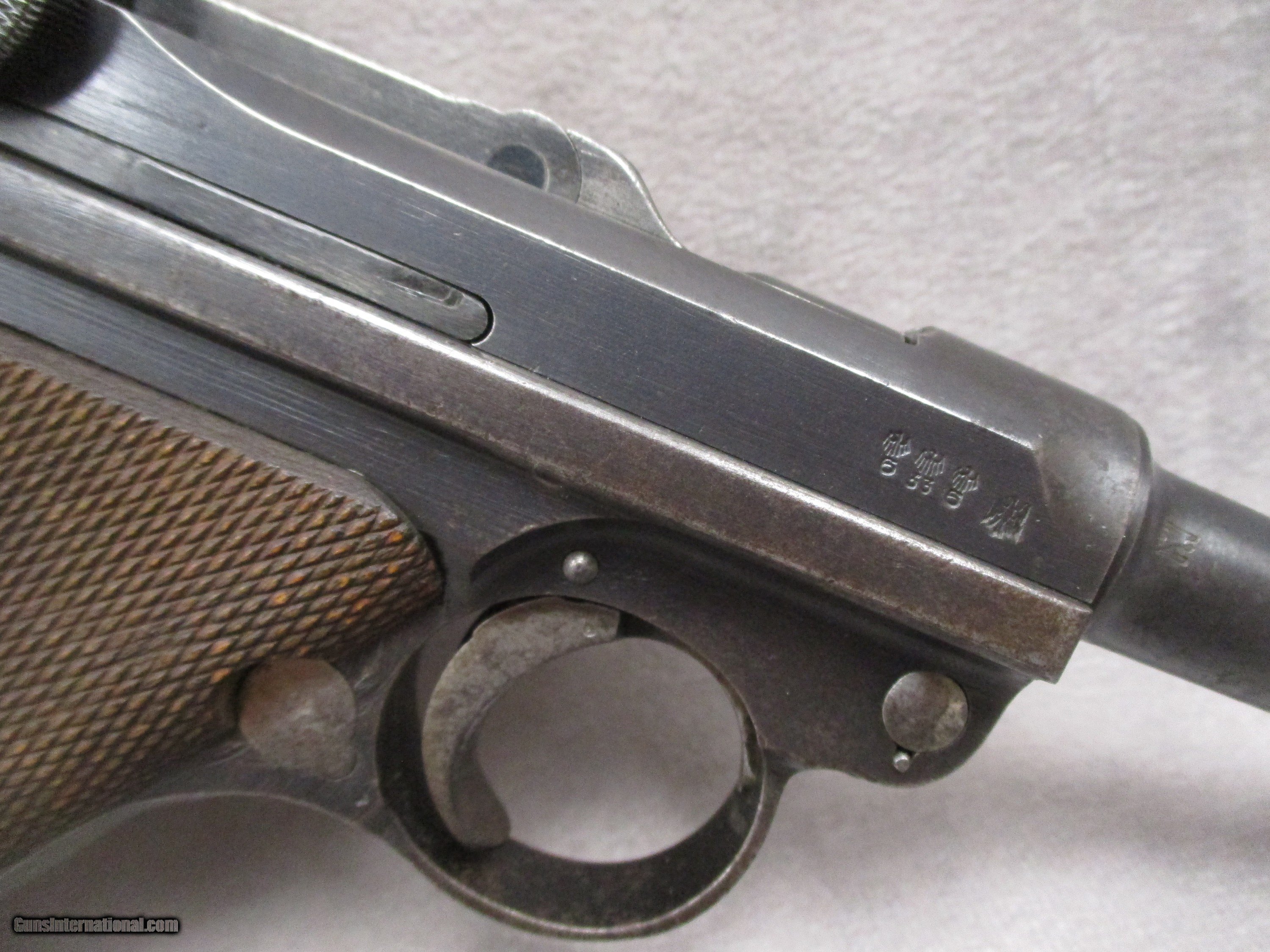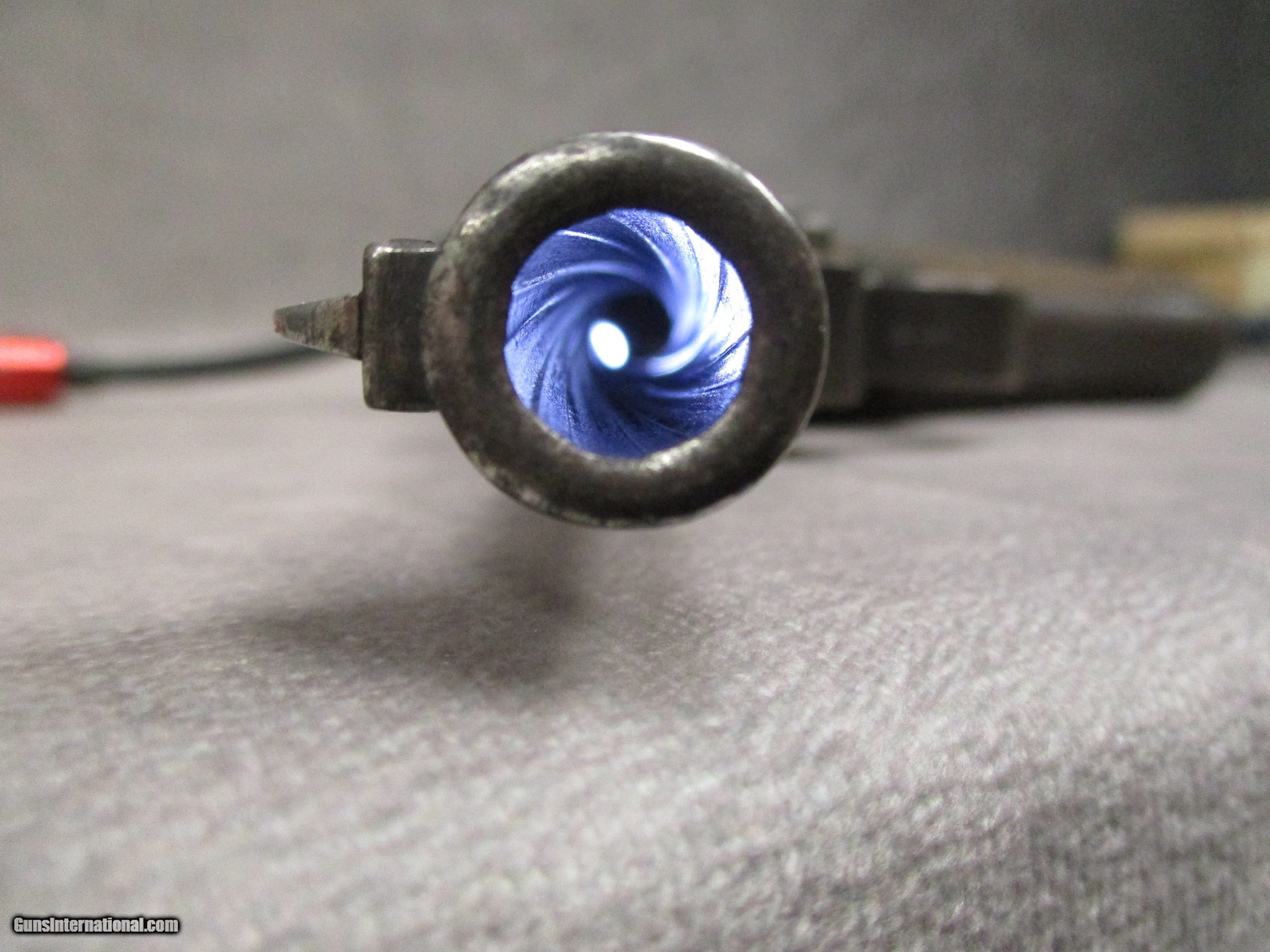Your Session is Ending
 The server has not detected any activity for the last 3 hours.
For your security, your session will expire in 2 minutes and you will be redirected to the Sign In page.
Would you like to stay signed in?
The server has not detected any activity for the last 3 hours.
For your security, your session will expire in 2 minutes and you will be redirected to the Sign In page.
Would you like to stay signed in?
Simson & Co. P.08 Luger 9mm with Mauser S/42 Toggle, Non-import with 1941 Holster for sale
Simson & Co. P.08 Luger 9mm with Mauser S/42 Toggle, Non-import with 1941 Holster for sale
Guns International #: 102872918
Seller's Inventory #: 24100083
Category - Luger Pistols
- Military Pistols - German
Simson & Co. P.08 Luger 9mm with Mauser S/42 Toggle, Non-import with 1941 Holster
Description:
What we have here is a hybrid of a P.08 Luger pistol built by Simson & Co. for the Reichsheer (German Army 1920 – 1935) and fitted with a Mauser S/42 toggle. After World War I, most Luger pistols built during and before the war were either worn out and needed rebuilding or were taken home by Entente personnel, especially by members of the American Expeditionary Force (AEF). Germany was also in a need to pay off the A and B debts stipulated in the Versailles Treaty. One way of doing this was by taking the good parts from the worn out Lugers and putting them together as a functional pistol and selling them on the open market. Those pistols (which the current pistol is NOT one of) are referred to as “post-1920 reworks.” Under the Versailles Treaty, Germany was allowed to have a 100,000 man army. As mentioned previously, this force was known as the Reichsheer. This new army force needed new pistols as the older, worn out Lugers were not an option for the reasons mentioned above. With new P.08s required, the old, established firm of Simson & Co. was given a contract to supply Lugers to the Reichsheer. They were the only official suppliers of the Luger pistol for 10 years between 1922 – 1932. The first few pistols were assembled from parts left over from WW1 (new parts which had not yet been assembled into a full pistol). Later production Simson & Co. pistols were made from scratch. Meanwhile, in 1930, DWM changed hands, becoming a part of the same holding company that owned the famous Mauser Werke at Oberndorf. Starting on May 1st, 1930, up to 800 machines, tools, and technicians were transferred from the DWM factory located in Berlin to the Oberndorf location. After that, DWM was relegated to the back ground as far as arms production was concerned, while Mauser eventually became the foremost supplier of Lugers from then until production officially ended in 1942. Keep in mind, this move was made under great secrecy. Sales of Luger pistols to foreign militaries and civilian sales were not truly forbidden, only sales to the Reichsheer were not permitted (since it was limited to 100,000 men). Back at Simson & Co., the contract came to an end in 1932 as originally intended. However, with the Nazis coming to power in 1933 and the size of the German armed forces beginning to expand, production of Luger pistols began to increase. To keep the growth of production capacity for pistols a secret, the manufacturers involved were assigned code names (and code dates) intended to disguise which company the Luger pistols were made by. Mauser was assigned the code name “S/42.” The “S” stood for Simson & Co. to hide the fact that Mauser was producing the pistols, although some consider this to be apocryphal. However, there is a good deal of evidence indicating it to be the truth. A similar marking sequence can be found on German ammunition. Polte, a manufacturer in Magdeburg, was the only official supplier of ammunition and other companies producing it were given a “P” code, followed by a number as well. With the “S” in “S/42” standing for Simson, the current state of the pistol shown here is somewhat ironic.
The pistol is essentially matching except for the whole toggle system and the safety lever. Obviously, the magazine does not match as is usually the case with ex-military Lugers. The “Eagle over Six” stamp is prevalent on many of the parts including the front sight blade (the base to be specific; very small), the slide, the side plate, the takedown lever, the barrel, and the magazine release button (right-hand side). The “Eagle over 6” was the stamp assigned to Simson & Co. (Mauser never used that stamp on any of their pistols). On the right-hand side of the slide, there are two “Eagle over 6” stamps, and an “Eagle over 33” stamp (also a Simson & Co. stamp). To the right of these stamps is a larger Eagle stamp with no number below it. There are two “Eagle over 6” stamps, one larger than the other, on the front face of the trigger guard. The Simson & Co. parts are stamped with either the number 3655 (no letter suffix), or the number 55. The Mauser toggle system is stamped on each part with the number 48, while the manual thumb safety is stamped with the number 24. The thumb safety is notable for its finish which is very different from the rest of the pistol. Dating this pistol is difficult, not least because of German efforts as deception which were already being implemented the second that the two German representatives’ pens left the paper that was the Treaty of Versailles (June 28th, 1919). One of these methods was to stamp a pistol with an old year date. Certain depots were still marking pistols with 1920 property dates a late as 1935(!), or in our pistol’s case, not given a year date at all.
Visibly, it is obvious this P.08 has seen some combat use. The original finish is worn in most places, the front strap and backstrap being the most affected. Rust that was previously present has been cleaned up for the most part. The sides of the frame and the bottom of the barrel also exhibit wear, but to a much reduced extent. The serial number on the bottom of the barrel is still visible, though as is usually the case, the numbers are not perfectly stamped into the metal. This is mainly due to the rounded surface of the barrel itself. The stamps themselves were a relatively flat tool and trying to stamp that onto a “rolling” surface is not a recipe for success. It can be done, but the numbers will have parts which are shallow and those that are deep.
The bore is in relatively good shape. There appears to be some light frosting present, but the rifling remains clearly visible. The use of proper jacketed bullets should prevent this from affecting the accuracy of the pistol. One thing that most people do not realize about the Luger is what loads are required to make the pistol cycle reliably. The 9mm Parabellum’s original military load used a 123gr bullet yielding 327 m/s (1,072.83 ft/s) from a 4.0” (102 mm) or 3.9” (100 mm) barrel in order to reliably cycle the action. But, due to the Luger’s age, most people assume that, like many pistols of the early 20th Century, it requires “light” pressure loads. Some American-made 9mm loads, especially those which use 115gr bullets, may not reliably cycle the P.08’s action, even if the 115gr bullet is travelling faster than the 123gr bullet of the original load. Bullet weight can be just as important in cycling a semi-automatic pistol as the pressure the cartridge is loaded to. Standard American 124gr loads should work, but at no time should any ammo labeled as “+P” or “9mm NATO” be used in a P.08. The pistol is currently fitted with a replacement, new production ejector from Numrich Gun Parts Corp. It has been fitted to the pistol and functions well with snap caps. This is generally the true test of an ejector as firing live ammo means the bolt moves far faster and with enough momentum to eject a casing. Manual bolt operation is slower and less inertia, so if the ejector can work under those conditions, it will work just fine with live ammo. The original ejector is still present but was replaced for the reasons shown in picture # 11. On the outside near the forward end of the ejector “bar”, a piece has broken away. The physical ejector that kicks spent casings out is still present on the inside, but it would just be a matter of time before the whole ejector failed during firing. Picture # 11 was taken before the replacement was installed. Picture # 12 illustrates the pistol with the replacement ejector installed.
Except for the safety lever, the rest of the pistol appears to have never been refinished. The grips are in good shape for their age but are definitely original to the era. The holster that comes with the pistol is stamped “jme” below which is stamped the year “1941.” Beneath this is the Eagle and swastika stamp with the “WaA14” right below it. Over on the right is the large stamp “P.08.” At some point, someone lightly etched the letters “Z” and possibly “A” (the latter of which is sideways) onto the back of the holster. The pistol comes with the one magazine. The P.08 was a very popular trophy for U.S. troops to bring home to the states during both World Wars. Its ray-gun like appearance made it stand out amongst others, and its 55-degree grip angle (145 degree in Europe) make the P.08 a natural pointer – a useful feature for target shooting.
Price: $2,050.00
Handgun Caliber: 9x19mm Parabellum (9mm Luger, 9x19mm NATO)
Manufacturer: Simson & Co.
Model: P.08
Serial Number: 3655
Barrel Length: 3.9375 inches (100 mm)
Bore Info: Rifled, 6 grooves, 1:9.8 inches (1 in 250 mm) RH twist
Ejectors: Auto-ejection
Condition: Used - Good
Barrels: Carbon steel
Barrel Type: Tapering
Action: Semi-automatic, Toggle-locked, short recoil.
Triggers: Smooth face; classic Luger trigger.
Stock: Wood, checkered.
LOP: 2.75 inches (70 mm)
Finish: Rust Blued
Weight: 1 lb. 15.4 oz.
Sights: Fixed sights, sight radius 7.72 inches (196 mm)
Case: P.08 Holster
Description:
What we have here is a hybrid of a P.08 Luger pistol built by Simson & Co. for the Reichsheer (German Army 1920 – 1935) and fitted with a Mauser S/42 toggle. After World War I, most Luger pistols built during and before the war were either worn out and needed rebuilding or were taken home by Entente personnel, especially by members of the American Expeditionary Force (AEF). Germany was also in a need to pay off the A and B debts stipulated in the Versailles Treaty. One way of doing this was by taking the good parts from the worn out Lugers and putting them together as a functional pistol and selling them on the open market. Those pistols (which the current pistol is NOT one of) are referred to as “post-1920 reworks.” Under the Versailles Treaty, Germany was allowed to have a 100,000 man army. As mentioned previously, this force was known as the Reichsheer. This new army force needed new pistols as the older, worn out Lugers were not an option for the reasons mentioned above. With new P.08s required, the old, established firm of Simson & Co. was given a contract to supply Lugers to the Reichsheer. They were the only official suppliers of the Luger pistol for 10 years between 1922 – 1932. The first few pistols were assembled from parts left over from WW1 (new parts which had not yet been assembled into a full pistol). Later production Simson & Co. pistols were made from scratch. Meanwhile, in 1930, DWM changed hands, becoming a part of the same holding company that owned the famous Mauser Werke at Oberndorf. Starting on May 1st, 1930, up to 800 machines, tools, and technicians were transferred from the DWM factory located in Berlin to the Oberndorf location. After that, DWM was relegated to the back ground as far as arms production was concerned, while Mauser eventually became the foremost supplier of Lugers from then until production officially ended in 1942. Keep in mind, this move was made under great secrecy. Sales of Luger pistols to foreign militaries and civilian sales were not truly forbidden, only sales to the Reichsheer were not permitted (since it was limited to 100,000 men). Back at Simson & Co., the contract came to an end in 1932 as originally intended. However, with the Nazis coming to power in 1933 and the size of the German armed forces beginning to expand, production of Luger pistols began to increase. To keep the growth of production capacity for pistols a secret, the manufacturers involved were assigned code names (and code dates) intended to disguise which company the Luger pistols were made by. Mauser was assigned the code name “S/42.” The “S” stood for Simson & Co. to hide the fact that Mauser was producing the pistols, although some consider this to be apocryphal. However, there is a good deal of evidence indicating it to be the truth. A similar marking sequence can be found on German ammunition. Polte, a manufacturer in Magdeburg, was the only official supplier of ammunition and other companies producing it were given a “P” code, followed by a number as well. With the “S” in “S/42” standing for Simson, the current state of the pistol shown here is somewhat ironic.
The pistol is essentially matching except for the whole toggle system and the safety lever. Obviously, the magazine does not match as is usually the case with ex-military Lugers. The “Eagle over Six” stamp is prevalent on many of the parts including the front sight blade (the base to be specific; very small), the slide, the side plate, the takedown lever, the barrel, and the magazine release button (right-hand side). The “Eagle over 6” was the stamp assigned to Simson & Co. (Mauser never used that stamp on any of their pistols). On the right-hand side of the slide, there are two “Eagle over 6” stamps, and an “Eagle over 33” stamp (also a Simson & Co. stamp). To the right of these stamps is a larger Eagle stamp with no number below it. There are two “Eagle over 6” stamps, one larger than the other, on the front face of the trigger guard. The Simson & Co. parts are stamped with either the number 3655 (no letter suffix), or the number 55. The Mauser toggle system is stamped on each part with the number 48, while the manual thumb safety is stamped with the number 24. The thumb safety is notable for its finish which is very different from the rest of the pistol. Dating this pistol is difficult, not least because of German efforts as deception which were already being implemented the second that the two German representatives’ pens left the paper that was the Treaty of Versailles (June 28th, 1919). One of these methods was to stamp a pistol with an old year date. Certain depots were still marking pistols with 1920 property dates a late as 1935(!), or in our pistol’s case, not given a year date at all.
Visibly, it is obvious this P.08 has seen some combat use. The original finish is worn in most places, the front strap and backstrap being the most affected. Rust that was previously present has been cleaned up for the most part. The sides of the frame and the bottom of the barrel also exhibit wear, but to a much reduced extent. The serial number on the bottom of the barrel is still visible, though as is usually the case, the numbers are not perfectly stamped into the metal. This is mainly due to the rounded surface of the barrel itself. The stamps themselves were a relatively flat tool and trying to stamp that onto a “rolling” surface is not a recipe for success. It can be done, but the numbers will have parts which are shallow and those that are deep.
The bore is in relatively good shape. There appears to be some light frosting present, but the rifling remains clearly visible. The use of proper jacketed bullets should prevent this from affecting the accuracy of the pistol. One thing that most people do not realize about the Luger is what loads are required to make the pistol cycle reliably. The 9mm Parabellum’s original military load used a 123gr bullet yielding 327 m/s (1,072.83 ft/s) from a 4.0” (102 mm) or 3.9” (100 mm) barrel in order to reliably cycle the action. But, due to the Luger’s age, most people assume that, like many pistols of the early 20th Century, it requires “light” pressure loads. Some American-made 9mm loads, especially those which use 115gr bullets, may not reliably cycle the P.08’s action, even if the 115gr bullet is travelling faster than the 123gr bullet of the original load. Bullet weight can be just as important in cycling a semi-automatic pistol as the pressure the cartridge is loaded to. Standard American 124gr loads should work, but at no time should any ammo labeled as “+P” or “9mm NATO” be used in a P.08. The pistol is currently fitted with a replacement, new production ejector from Numrich Gun Parts Corp. It has been fitted to the pistol and functions well with snap caps. This is generally the true test of an ejector as firing live ammo means the bolt moves far faster and with enough momentum to eject a casing. Manual bolt operation is slower and less inertia, so if the ejector can work under those conditions, it will work just fine with live ammo. The original ejector is still present but was replaced for the reasons shown in picture # 11. On the outside near the forward end of the ejector “bar”, a piece has broken away. The physical ejector that kicks spent casings out is still present on the inside, but it would just be a matter of time before the whole ejector failed during firing. Picture # 11 was taken before the replacement was installed. Picture # 12 illustrates the pistol with the replacement ejector installed.
Except for the safety lever, the rest of the pistol appears to have never been refinished. The grips are in good shape for their age but are definitely original to the era. The holster that comes with the pistol is stamped “jme” below which is stamped the year “1941.” Beneath this is the Eagle and swastika stamp with the “WaA14” right below it. Over on the right is the large stamp “P.08.” At some point, someone lightly etched the letters “Z” and possibly “A” (the latter of which is sideways) onto the back of the holster. The pistol comes with the one magazine. The P.08 was a very popular trophy for U.S. troops to bring home to the states during both World Wars. Its ray-gun like appearance made it stand out amongst others, and its 55-degree grip angle (145 degree in Europe) make the P.08 a natural pointer – a useful feature for target shooting.
Price: $2,050.00
Handgun Caliber: 9x19mm Parabellum (9mm Luger, 9x19mm NATO)
Manufacturer: Simson & Co.
Model: P.08
Serial Number: 3655
Barrel Length: 3.9375 inches (100 mm)
Bore Info: Rifled, 6 grooves, 1:9.8 inches (1 in 250 mm) RH twist
Ejectors: Auto-ejection
Condition: Used - Good
Barrels: Carbon steel
Barrel Type: Tapering
Action: Semi-automatic, Toggle-locked, short recoil.
Triggers: Smooth face; classic Luger trigger.
Stock: Wood, checkered.
LOP: 2.75 inches (70 mm)
Finish: Rust Blued
Weight: 1 lb. 15.4 oz.
Sights: Fixed sights, sight radius 7.72 inches (196 mm)
Case: P.08 Holster
Contact Seller
Click Photo to Enlarge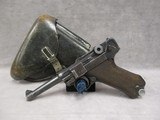
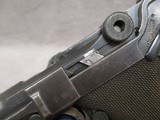
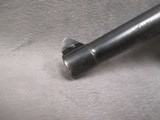
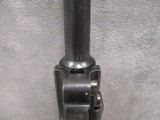

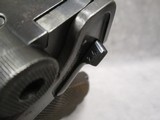
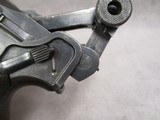
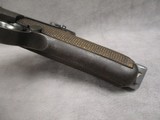
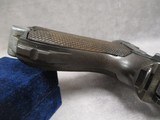


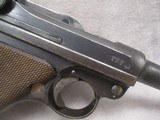
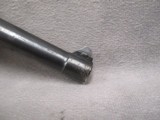
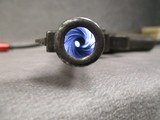
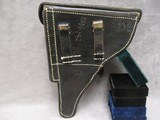
|
Guns International #: 102872918
Category - Luger Pistols
- Military Pistols - German
Simson & Co. P.08 Luger 9mm with Mauser S/42 Toggle, Non-import with 1941 Holster
Description: What we have here is a hybrid of a P.08 Luger pistol built by Simson & Co. for the Reichsheer (German Army 1920 – 1935) and fitted with a Mauser S/42 toggle. After World War I, most Luger pistols built during and before the war were either worn out and needed rebuilding or were taken home by Entente personnel, especially by members of the American Expeditionary Force (AEF). Germany was also in a need to pay off the A and B debts stipulated in the Versailles Treaty. One way of doing this was by taking the good parts from the worn out Lugers and putting them together as a functional pistol and selling them on the open market. Those pistols (which the current pistol is NOT one of) are referred to as “post-1920 reworks.” Under the Versailles Treaty, Germany was allowed to have a 100,000 man army. As mentioned previously, this force was known as the Reichsheer. This new army force needed new pistols as the older, worn out Lugers were not an option for the reasons mentioned above. With new P.08s required, the old, established firm of Simson & Co. was given a contract to supply Lugers to the Reichsheer. They were the only official suppliers of the Luger pistol for 10 years between 1922 – 1932. The first few pistols were assembled from parts left over from WW1 (new parts which had not yet been assembled into a full pistol). Later production Simson & Co. pistols were made from scratch. Meanwhile, in 1930, DWM changed hands, becoming a part of the same holding company that owned the famous Mauser Werke at Oberndorf. Starting on May 1st, 1930, up to 800 machines, tools, and technicians were transferred from the DWM factory located in Berlin to the Oberndorf location. After that, DWM was relegated to the back ground as far as arms production was concerned, while Mauser eventually became the foremost supplier of Lugers from then until production officially ended in 1942. Keep in mind, this move was made under great secrecy. Sales of Luger pistols to foreign militaries and civilian sales were not truly forbidden, only sales to the Reichsheer were not permitted (since it was limited to 100,000 men). Back at Simson & Co., the contract came to an end in 1932 as originally intended. However, with the Nazis coming to power in 1933 and the size of the German armed forces beginning to expand, production of Luger pistols began to increase. To keep the growth of production capacity for pistols a secret, the manufacturers involved were assigned code names (and code dates) intended to disguise which company the Luger pistols were made by. Mauser was assigned the code name “S/42.” The “S” stood for Simson & Co. to hide the fact that Mauser was producing the pistols, although some consider this to be apocryphal. However, there is a good deal of evidence indicating it to be the truth. A similar marking sequence can be found on German ammunition. Polte, a manufacturer in Magdeburg, was the only official supplier of ammunition and other companies producing it were given a “P” code, followed by a number as well. With the “S” in “S/42” standing for Simson, the current state of the pistol shown here is somewhat ironic. The pistol is essentially matching except for the whole toggle system and the safety lever. Obviously, the magazine does not match as is usually the case with ex-military Lugers. The “Eagle over Six” stamp is prevalent on many of the parts including the front sight blade (the base to be specific; very small), the slide, the side plate, the takedown lever, the barrel, and the magazine release button (right-hand side). The “Eagle over 6” was the stamp assigned to Simson & Co. (Mauser never used that stamp on any of their pistols). On the right-hand side of the slide, there are two “Eagle over 6” stamps, and an “Eagle over 33” stamp (also a Simson & Co. stamp). To the right of these stamps is a larger Eagle stamp with no number below it. There are two “Eagle over 6” stamps, one larger than the other, on the front face of the trigger guard. The Simson & Co. parts are stamped with either the number 3655 (no letter suffix), or the number 55. The Mauser toggle system is stamped on each part with the number 48, while the manual thumb safety is stamped with the number 24. The thumb safety is notable for its finish which is very different from the rest of the pistol. Dating this pistol is difficult, not least because of German efforts as deception which were already being implemented the second that the two German representatives’ pens left the paper that was the Treaty of Versailles (June 28th, 1919). One of these methods was to stamp a pistol with an old year date. Certain depots were still marking pistols with 1920 property dates a late as 1935(!), or in our pistol’s case, not given a year date at all. Visibly, it is obvious this P.08 has seen some combat use. The original finish is worn in most places, the front strap and backstrap being the most affected. Rust that was previously present has been cleaned up for the most part. The sides of the frame and the bottom of the barrel also exhibit wear, but to a much reduced extent. The serial number on the bottom of the barrel is still visible, though as is usually the case, the numbers are not perfectly stamped into the metal. This is mainly due to the rounded surface of the barrel itself. The stamps themselves were a relatively flat tool and trying to stamp that onto a “rolling” surface is not a recipe for success. It can be done, but the numbers will have parts which are shallow and those that are deep. The bore is in relatively good shape. There appears to be some light frosting present, but the rifling remains clearly visible. The use of proper jacketed bullets should prevent this from affecting the accuracy of the pistol. One thing that most people do not realize about the Luger is what loads are required to make the pistol cycle reliably. The 9mm Parabellum’s original military load used a 123gr bullet yielding 327 m/s (1,072.83 ft/s) from a 4.0” (102 mm) or 3.9” (100 mm) barrel in order to reliably cycle the action. But, due to the Luger’s age, most people assume that, like many pistols of the early 20th Century, it requires “light” pressure loads. Some American-made 9mm loads, especially those which use 115gr bullets, may not reliably cycle the P.08’s action, even if the 115gr bullet is travelling faster than the 123gr bullet of the original load. Bullet weight can be just as important in cycling a semi-automatic pistol as the pressure the cartridge is loaded to. Standard American 124gr loads should work, but at no time should any ammo labeled as “+P” or “9mm NATO” be used in a P.08. The pistol is currently fitted with a replacement, new production ejector from Numrich Gun Parts Corp. It has been fitted to the pistol and functions well with snap caps. This is generally the true test of an ejector as firing live ammo means the bolt moves far faster and with enough momentum to eject a casing. Manual bolt operation is slower and less inertia, so if the ejector can work under those conditions, it will work just fine with live ammo. The original ejector is still present but was replaced for the reasons shown in picture # 11. On the outside near the forward end of the ejector “bar”, a piece has broken away. The physical ejector that kicks spent casings out is still present on the inside, but it would just be a matter of time before the whole ejector failed during firing. Picture # 11 was taken before the replacement was installed. Picture # 12 illustrates the pistol with the replacement ejector installed. Except for the safety lever, the rest of the pistol appears to have never been refinished. The grips are in good shape for their age but are definitely original to the era. The holster that comes with the pistol is stamped “jme” below which is stamped the year “1941.” Beneath this is the Eagle and swastika stamp with the “WaA14” right below it. Over on the right is the large stamp “P.08.” At some point, someone lightly etched the letters “Z” and possibly “A” (the latter of which is sideways) onto the back of the holster. The pistol comes with the one magazine. The P.08 was a very popular trophy for U.S. troops to bring home to the states during both World Wars. Its ray-gun like appearance made it stand out amongst others, and its 55-degree grip angle (145 degree in Europe) make the P.08 a natural pointer – a useful feature for target shooting. Price: $2,050.00 Handgun Caliber: 9x19mm Parabellum (9mm Luger, 9x19mm NATO) Manufacturer: Simson & Co. Model: P.08 Serial Number: 3655 Barrel Length: 3.9375 inches (100 mm) Bore Info: Rifled, 6 grooves, 1:9.8 inches (1 in 250 mm) RH twist Ejectors: Auto-ejection Condition: Used - Good Barrels: Carbon steel Barrel Type: Tapering Action: Semi-automatic, Toggle-locked, short recoil. Triggers: Smooth face; classic Luger trigger. Stock: Wood, checkered. LOP: 2.75 inches (70 mm) Finish: Rust Blued Weight: 1 lb. 15.4 oz. Sights: Fixed sights, sight radius 7.72 inches (196 mm) Case: P.08 Holster Contact Seller |
Guns International #: 102872918
Seller's Inventory #: 24100083
Category - Luger Pistols
- Military Pistols - German
Simson & Co. P.08 Luger 9mm with Mauser S/42 Toggle, Non-import with 1941 Holster
Description:
What we have here is a hybrid of a P.08 Luger pistol built by Simson & Co. for the Reichsheer (German Army 1920 – 1935) and fitted with a Mauser S/42 toggle. After World War I, most Luger pistols built during and before the war were either worn out and needed rebuilding or were taken home by Entente personnel, especially by members of the American Expeditionary Force (AEF). Germany was also in a need to pay off the A and B debts stipulated in the Versailles Treaty. One way of doing this was by taking the good parts from the worn out Lugers and putting them together as a functional pistol and selling them on the open market. Those pistols (which the current pistol is NOT one of) are referred to as “post-1920 reworks.” Under the Versailles Treaty, Germany was allowed to have a 100,000 man army. As mentioned previously, this force was known as the Reichsheer. This new army force needed new pistols as the older, worn out Lugers were not an option for the reasons mentioned above. With new P.08s required, the old, established firm of Simson & Co. was given a contract to supply Lugers to the Reichsheer. They were the only official suppliers of the Luger pistol for 10 years between 1922 – 1932. The first few pistols were assembled from parts left over from WW1 (new parts which had not yet been assembled into a full pistol). Later production Simson & Co. pistols were made from scratch. Meanwhile, in 1930, DWM changed hands, becoming a part of the same holding company that owned the famous Mauser Werke at Oberndorf. Starting on May 1st, 1930, up to 800 machines, tools, and technicians were transferred from the DWM factory located in Berlin to the Oberndorf location. After that, DWM was relegated to the back ground as far as arms production was concerned, while Mauser eventually became the foremost supplier of Lugers from then until production officially ended in 1942. Keep in mind, this move was made under great secrecy. Sales of Luger pistols to foreign militaries and civilian sales were not truly forbidden, only sales to the Reichsheer were not permitted (since it was limited to 100,000 men). Back at Simson & Co., the contract came to an end in 1932 as originally intended. However, with the Nazis coming to power in 1933 and the size of the German armed forces beginning to expand, production of Luger pistols began to increase. To keep the growth of production capacity for pistols a secret, the manufacturers involved were assigned code names (and code dates) intended to disguise which company the Luger pistols were made by. Mauser was assigned the code name “S/42.” The “S” stood for Simson & Co. to hide the fact that Mauser was producing the pistols, although some consider this to be apocryphal. However, there is a good deal of evidence indicating it to be the truth. A similar marking sequence can be found on German ammunition. Polte, a manufacturer in Magdeburg, was the only official supplier of ammunition and other companies producing it were given a “P” code, followed by a number as well. With the “S” in “S/42” standing for Simson, the current state of the pistol shown here is somewhat ironic.
The pistol is essentially matching except for the whole toggle system and the safety lever. Obviously, the magazine does not match as is usually the case with ex-military Lugers. The “Eagle over Six” stamp is prevalent on many of the parts including the front sight blade (the base to be specific; very small), the slide, the side plate, the takedown lever, the barrel, and the magazine release button (right-hand side). The “Eagle over 6” was the stamp assigned to Simson & Co. (Mauser never used that stamp on any of their pistols). On the right-hand side of the slide, there are two “Eagle over 6” stamps, and an “Eagle over 33” stamp (also a Simson & Co. stamp). To the right of these stamps is a larger Eagle stamp with no number below it. There are two “Eagle over 6” stamps, one larger than the other, on the front face of the trigger guard. The Simson & Co. parts are stamped with either the number 3655 (no letter suffix), or the number 55. The Mauser toggle system is stamped on each part with the number 48, while the manual thumb safety is stamped with the number 24. The thumb safety is notable for its finish which is very different from the rest of the pistol. Dating this pistol is difficult, not least because of German efforts as deception which were already being implemented the second that the two German representatives’ pens left the paper that was the Treaty of Versailles (June 28th, 1919). One of these methods was to stamp a pistol with an old year date. Certain depots were still marking pistols with 1920 property dates a late as 1935(!), or in our pistol’s case, not given a year date at all.
Visibly, it is obvious this P.08 has seen some combat use. The original finish is worn in most places, the front strap and backstrap being the most affected. Rust that was previously present has been cleaned up for the most part. The sides of the frame and the bottom of the barrel also exhibit wear, but to a much reduced extent. The serial number on the bottom of the barrel is still visible, though as is usually the case, the numbers are not perfectly stamped into the metal. This is mainly due to the rounded surface of the barrel itself. The stamps themselves were a relatively flat tool and trying to stamp that onto a “rolling” surface is not a recipe for success. It can be done, but the numbers will have parts which are shallow and those that are deep.
The bore is in relatively good shape. There appears to be some light frosting present, but the rifling remains clearly visible. The use of proper jacketed bullets should prevent this from affecting the accuracy of the pistol. One thing that most people do not realize about the Luger is what loads are required to make the pistol cycle reliably. The 9mm Parabellum’s original military load used a 123gr bullet yielding 327 m/s (1,072.83 ft/s) from a 4.0” (102 mm) or 3.9” (100 mm) barrel in order to reliably cycle the action. But, due to the Luger’s age, most people assume that, like many pistols of the early 20th Century, it requires “light” pressure loads. Some American-made 9mm loads, especially those which use 115gr bullets, may not reliably cycle the P.08’s action, even if the 115gr bullet is travelling faster than the 123gr bullet of the original load. Bullet weight can be just as important in cycling a semi-automatic pistol as the pressure the cartridge is loaded to. Standard American 124gr loads should work, but at no time should any ammo labeled as “+P” or “9mm NATO” be used in a P.08. The pistol is currently fitted with a replacement, new production ejector from Numrich Gun Parts Corp. It has been fitted to the pistol and functions well with snap caps. This is generally the true test of an ejector as firing live ammo means the bolt moves far faster and with enough momentum to eject a casing. Manual bolt operation is slower and less inertia, so if the ejector can work under those conditions, it will work just fine with live ammo. The original ejector is still present but was replaced for the reasons shown in picture # 11. On the outside near the forward end of the ejector “bar”, a piece has broken away. The physical ejector that kicks spent casings out is still present on the inside, but it would just be a matter of time before the whole ejector failed during firing. Picture # 11 was taken before the replacement was installed. Picture # 12 illustrates the pistol with the replacement ejector installed.
Except for the safety lever, the rest of the pistol appears to have never been refinished. The grips are in good shape for their age but are definitely original to the era. The holster that comes with the pistol is stamped “jme” below which is stamped the year “1941.” Beneath this is the Eagle and swastika stamp with the “WaA14” right below it. Over on the right is the large stamp “P.08.” At some point, someone lightly etched the letters “Z” and possibly “A” (the latter of which is sideways) onto the back of the holster. The pistol comes with the one magazine. The P.08 was a very popular trophy for U.S. troops to bring home to the states during both World Wars. Its ray-gun like appearance made it stand out amongst others, and its 55-degree grip angle (145 degree in Europe) make the P.08 a natural pointer – a useful feature for target shooting.
Price: $2,050.00
Handgun Caliber: 9x19mm Parabellum (9mm Luger, 9x19mm NATO)
Manufacturer: Simson & Co.
Model: P.08
Serial Number: 3655
Barrel Length: 3.9375 inches (100 mm)
Bore Info: Rifled, 6 grooves, 1:9.8 inches (1 in 250 mm) RH twist
Ejectors: Auto-ejection
Condition: Used - Good
Barrels: Carbon steel
Barrel Type: Tapering
Action: Semi-automatic, Toggle-locked, short recoil.
Triggers: Smooth face; classic Luger trigger.
Stock: Wood, checkered.
LOP: 2.75 inches (70 mm)
Finish: Rust Blued
Weight: 1 lb. 15.4 oz.
Sights: Fixed sights, sight radius 7.72 inches (196 mm)
Case: P.08 Holster
Description:
What we have here is a hybrid of a P.08 Luger pistol built by Simson & Co. for the Reichsheer (German Army 1920 – 1935) and fitted with a Mauser S/42 toggle. After World War I, most Luger pistols built during and before the war were either worn out and needed rebuilding or were taken home by Entente personnel, especially by members of the American Expeditionary Force (AEF). Germany was also in a need to pay off the A and B debts stipulated in the Versailles Treaty. One way of doing this was by taking the good parts from the worn out Lugers and putting them together as a functional pistol and selling them on the open market. Those pistols (which the current pistol is NOT one of) are referred to as “post-1920 reworks.” Under the Versailles Treaty, Germany was allowed to have a 100,000 man army. As mentioned previously, this force was known as the Reichsheer. This new army force needed new pistols as the older, worn out Lugers were not an option for the reasons mentioned above. With new P.08s required, the old, established firm of Simson & Co. was given a contract to supply Lugers to the Reichsheer. They were the only official suppliers of the Luger pistol for 10 years between 1922 – 1932. The first few pistols were assembled from parts left over from WW1 (new parts which had not yet been assembled into a full pistol). Later production Simson & Co. pistols were made from scratch. Meanwhile, in 1930, DWM changed hands, becoming a part of the same holding company that owned the famous Mauser Werke at Oberndorf. Starting on May 1st, 1930, up to 800 machines, tools, and technicians were transferred from the DWM factory located in Berlin to the Oberndorf location. After that, DWM was relegated to the back ground as far as arms production was concerned, while Mauser eventually became the foremost supplier of Lugers from then until production officially ended in 1942. Keep in mind, this move was made under great secrecy. Sales of Luger pistols to foreign militaries and civilian sales were not truly forbidden, only sales to the Reichsheer were not permitted (since it was limited to 100,000 men). Back at Simson & Co., the contract came to an end in 1932 as originally intended. However, with the Nazis coming to power in 1933 and the size of the German armed forces beginning to expand, production of Luger pistols began to increase. To keep the growth of production capacity for pistols a secret, the manufacturers involved were assigned code names (and code dates) intended to disguise which company the Luger pistols were made by. Mauser was assigned the code name “S/42.” The “S” stood for Simson & Co. to hide the fact that Mauser was producing the pistols, although some consider this to be apocryphal. However, there is a good deal of evidence indicating it to be the truth. A similar marking sequence can be found on German ammunition. Polte, a manufacturer in Magdeburg, was the only official supplier of ammunition and other companies producing it were given a “P” code, followed by a number as well. With the “S” in “S/42” standing for Simson, the current state of the pistol shown here is somewhat ironic.
The pistol is essentially matching except for the whole toggle system and the safety lever. Obviously, the magazine does not match as is usually the case with ex-military Lugers. The “Eagle over Six” stamp is prevalent on many of the parts including the front sight blade (the base to be specific; very small), the slide, the side plate, the takedown lever, the barrel, and the magazine release button (right-hand side). The “Eagle over 6” was the stamp assigned to Simson & Co. (Mauser never used that stamp on any of their pistols). On the right-hand side of the slide, there are two “Eagle over 6” stamps, and an “Eagle over 33” stamp (also a Simson & Co. stamp). To the right of these stamps is a larger Eagle stamp with no number below it. There are two “Eagle over 6” stamps, one larger than the other, on the front face of the trigger guard. The Simson & Co. parts are stamped with either the number 3655 (no letter suffix), or the number 55. The Mauser toggle system is stamped on each part with the number 48, while the manual thumb safety is stamped with the number 24. The thumb safety is notable for its finish which is very different from the rest of the pistol. Dating this pistol is difficult, not least because of German efforts as deception which were already being implemented the second that the two German representatives’ pens left the paper that was the Treaty of Versailles (June 28th, 1919). One of these methods was to stamp a pistol with an old year date. Certain depots were still marking pistols with 1920 property dates a late as 1935(!), or in our pistol’s case, not given a year date at all.
Visibly, it is obvious this P.08 has seen some combat use. The original finish is worn in most places, the front strap and backstrap being the most affected. Rust that was previously present has been cleaned up for the most part. The sides of the frame and the bottom of the barrel also exhibit wear, but to a much reduced extent. The serial number on the bottom of the barrel is still visible, though as is usually the case, the numbers are not perfectly stamped into the metal. This is mainly due to the rounded surface of the barrel itself. The stamps themselves were a relatively flat tool and trying to stamp that onto a “rolling” surface is not a recipe for success. It can be done, but the numbers will have parts which are shallow and those that are deep.
The bore is in relatively good shape. There appears to be some light frosting present, but the rifling remains clearly visible. The use of proper jacketed bullets should prevent this from affecting the accuracy of the pistol. One thing that most people do not realize about the Luger is what loads are required to make the pistol cycle reliably. The 9mm Parabellum’s original military load used a 123gr bullet yielding 327 m/s (1,072.83 ft/s) from a 4.0” (102 mm) or 3.9” (100 mm) barrel in order to reliably cycle the action. But, due to the Luger’s age, most people assume that, like many pistols of the early 20th Century, it requires “light” pressure loads. Some American-made 9mm loads, especially those which use 115gr bullets, may not reliably cycle the P.08’s action, even if the 115gr bullet is travelling faster than the 123gr bullet of the original load. Bullet weight can be just as important in cycling a semi-automatic pistol as the pressure the cartridge is loaded to. Standard American 124gr loads should work, but at no time should any ammo labeled as “+P” or “9mm NATO” be used in a P.08. The pistol is currently fitted with a replacement, new production ejector from Numrich Gun Parts Corp. It has been fitted to the pistol and functions well with snap caps. This is generally the true test of an ejector as firing live ammo means the bolt moves far faster and with enough momentum to eject a casing. Manual bolt operation is slower and less inertia, so if the ejector can work under those conditions, it will work just fine with live ammo. The original ejector is still present but was replaced for the reasons shown in picture # 11. On the outside near the forward end of the ejector “bar”, a piece has broken away. The physical ejector that kicks spent casings out is still present on the inside, but it would just be a matter of time before the whole ejector failed during firing. Picture # 11 was taken before the replacement was installed. Picture # 12 illustrates the pistol with the replacement ejector installed.
Except for the safety lever, the rest of the pistol appears to have never been refinished. The grips are in good shape for their age but are definitely original to the era. The holster that comes with the pistol is stamped “jme” below which is stamped the year “1941.” Beneath this is the Eagle and swastika stamp with the “WaA14” right below it. Over on the right is the large stamp “P.08.” At some point, someone lightly etched the letters “Z” and possibly “A” (the latter of which is sideways) onto the back of the holster. The pistol comes with the one magazine. The P.08 was a very popular trophy for U.S. troops to bring home to the states during both World Wars. Its ray-gun like appearance made it stand out amongst others, and its 55-degree grip angle (145 degree in Europe) make the P.08 a natural pointer – a useful feature for target shooting.
Price: $2,050.00
Handgun Caliber: 9x19mm Parabellum (9mm Luger, 9x19mm NATO)
Manufacturer: Simson & Co.
Model: P.08
Serial Number: 3655
Barrel Length: 3.9375 inches (100 mm)
Bore Info: Rifled, 6 grooves, 1:9.8 inches (1 in 250 mm) RH twist
Ejectors: Auto-ejection
Condition: Used - Good
Barrels: Carbon steel
Barrel Type: Tapering
Action: Semi-automatic, Toggle-locked, short recoil.
Triggers: Smooth face; classic Luger trigger.
Stock: Wood, checkered.
LOP: 2.75 inches (70 mm)
Finish: Rust Blued
Weight: 1 lb. 15.4 oz.
Sights: Fixed sights, sight radius 7.72 inches (196 mm)
Case: P.08 Holster
Guns International #: 102872918
Seller's Inventory #: 24100083


Guns International #: 102872918
Seller's Inventory #: 24100083
Category - Luger Pistols
- Military Pistols - German
Simson & Co. P.08 Luger 9mm with Mauser S/42 Toggle, Non-import with 1941 Holster
Description:
What we have here is a hybrid of a P.08 Luger pistol built by Simson & Co. for the Reichsheer (German Army 1920 – 1935) and fitted with a Mauser S/42 toggle. After World War I, most Luger pistols built during and before the war were either worn out and needed rebuilding or were taken home by Entente personnel, especially by members of the American Expeditionary Force (AEF). Germany was also in a need to pay off the A and B debts stipulated in the Versailles Treaty. One way of doing this was by taking the good parts from the worn out Lugers and putting them together as a functional pistol and selling them on the open market. Those pistols (which the current pistol is NOT one of) are referred to as “post-1920 reworks.” Under the Versailles Treaty, Germany was allowed to have a 100,000 man army. As mentioned previously, this force was known as the Reichsheer. This new army force needed new pistols as the older, worn out Lugers were not an option for the reasons mentioned above. With new P.08s required, the old, established firm of Simson & Co. was given a contract to supply Lugers to the Reichsheer. They were the only official suppliers of the Luger pistol for 10 years between 1922 – 1932. The first few pistols were assembled from parts left over from WW1 (new parts which had not yet been assembled into a full pistol). Later production Simson & Co. pistols were made from scratch. Meanwhile, in 1930, DWM changed hands, becoming a part of the same holding company that owned the famous Mauser Werke at Oberndorf. Starting on May 1st, 1930, up to 800 machines, tools, and technicians were transferred from the DWM factory located in Berlin to the Oberndorf location. After that, DWM was relegated to the back ground as far as arms production was concerned, while Mauser eventually became the foremost supplier of Lugers from then until production officially ended in 1942. Keep in mind, this move was made under great secrecy. Sales of Luger pistols to foreign militaries and civilian sales were not truly forbidden, only sales to the Reichsheer were not permitted (since it was limited to 100,000 men). Back at Simson & Co., the contract came to an end in 1932 as originally intended. However, with the Nazis coming to power in 1933 and the size of the German armed forces beginning to expand, production of Luger pistols began to increase. To keep the growth of production capacity for pistols a secret, the manufacturers involved were assigned code names (and code dates) intended to disguise which company the Luger pistols were made by. Mauser was assigned the code name “S/42.” The “S” stood for Simson & Co. to hide the fact that Mauser was producing the pistols, although some consider this to be apocryphal. However, there is a good deal of evidence indicating it to be the truth. A similar marking sequence can be found on German ammunition. Polte, a manufacturer in Magdeburg, was the only official supplier of ammunition and other companies producing it were given a “P” code, followed by a number as well. With the “S” in “S/42” standing for Simson, the current state of the pistol shown here is somewhat ironic.
The pistol is essentially matching except for the whole toggle system and the safety lever. Obviously, the magazine does not match as is usually the case with ex-military Lugers. The “Eagle over Six” stamp is prevalent on many of the parts including the front sight blade (the base to be specific; very small), the slide, the side plate, the takedown lever, the barrel, and the magazine release button (right-hand side). The “Eagle over 6” was the stamp assigned to Simson & Co. (Mauser never used that stamp on any of their pistols). On the right-hand side of the slide, there are two “Eagle over 6” stamps, and an “Eagle over 33” stamp (also a Simson & Co. stamp). To the right of these stamps is a larger Eagle stamp with no number below it. There are two “Eagle over 6” stamps, one larger than the other, on the front face of the trigger guard. The Simson & Co. parts are stamped with either the number 3655 (no letter suffix), or the number 55. The Mauser toggle system is stamped on each part with the number 48, while the manual thumb safety is stamped with the number 24. The thumb safety is notable for its finish which is very different from the rest of the pistol. Dating this pistol is difficult, not least because of German efforts as deception which were already being implemented the second that the two German representatives’ pens left the paper that was the Treaty of Versailles (June 28th, 1919). One of these methods was to stamp a pistol with an old year date. Certain depots were still marking pistols with 1920 property dates a late as 1935(!), or in our pistol’s case, not given a year date at all.
Visibly, it is obvious this P.08 has seen some combat use. The original finish is worn in most places, the front strap and backstrap being the most affected. Rust that was previously present has been cleaned up for the most part. The sides of the frame and the bottom of the barrel also exhibit wear, but to a much reduced extent. The serial number on the bottom of the barrel is still visible, though as is usually the case, the numbers are not perfectly stamped into the metal. This is mainly due to the rounded surface of the barrel itself. The stamps themselves were a relatively flat tool and trying to stamp that onto a “rolling” surface is not a recipe for success. It can be done, but the numbers will have parts which are shallow and those that are deep.
The bore is in relatively good shape. There appears to be some light frosting present, but the rifling remains clearly visible. The use of proper jacketed bullets should prevent this from affecting the accuracy of the pistol. One thing that most people do not realize about the Luger is what loads are required to make the pistol cycle reliably. The 9mm Parabellum’s original military load used a 123gr bullet yielding 327 m/s (1,072.83 ft/s) from a 4.0” (102 mm) or 3.9” (100 mm) barrel in order to reliably cycle the action. But, due to the Luger’s age, most people assume that, like many pistols of the early 20th Century, it requires “light” pressure loads. Some American-made 9mm loads, especially those which use 115gr bullets, may not reliably cycle the P.08’s action, even if the 115gr bullet is travelling faster than the 123gr bullet of the original load. Bullet weight can be just as important in cycling a semi-automatic pistol as the pressure the cartridge is loaded to. Standard American 124gr loads should work, but at no time should any ammo labeled as “+P” or “9mm NATO” be used in a P.08. The pistol is currently fitted with a replacement, new production ejector from Numrich Gun Parts Corp. It has been fitted to the pistol and functions well with snap caps. This is generally the true test of an ejector as firing live ammo means the bolt moves far faster and with enough momentum to eject a casing. Manual bolt operation is slower and less inertia, so if the ejector can work under those conditions, it will work just fine with live ammo. The original ejector is still present but was replaced for the reasons shown in picture # 11. On the outside near the forward end of the ejector “bar”, a piece has broken away. The physical ejector that kicks spent casings out is still present on the inside, but it would just be a matter of time before the whole ejector failed during firing. Picture # 11 was taken before the replacement was installed. Picture # 12 illustrates the pistol with the replacement ejector installed.
Except for the safety lever, the rest of the pistol appears to have never been refinished. The grips are in good shape for their age but are definitely original to the era. The holster that comes with the pistol is stamped “jme” below which is stamped the year “1941.” Beneath this is the Eagle and swastika stamp with the “WaA14” right below it. Over on the right is the large stamp “P.08.” At some point, someone lightly etched the letters “Z” and possibly “A” (the latter of which is sideways) onto the back of the holster. The pistol comes with the one magazine. The P.08 was a very popular trophy for U.S. troops to bring home to the states during both World Wars. Its ray-gun like appearance made it stand out amongst others, and its 55-degree grip angle (145 degree in Europe) make the P.08 a natural pointer – a useful feature for target shooting.
Price: $2,050.00
Handgun Caliber: 9x19mm Parabellum (9mm Luger, 9x19mm NATO)
Manufacturer: Simson & Co.
Model: P.08
Serial Number: 3655
Barrel Length: 3.9375 inches (100 mm)
Bore Info: Rifled, 6 grooves, 1:9.8 inches (1 in 250 mm) RH twist
Ejectors: Auto-ejection
Condition: Used - Good
Barrels: Carbon steel
Barrel Type: Tapering
Action: Semi-automatic, Toggle-locked, short recoil.
Triggers: Smooth face; classic Luger trigger.
Stock: Wood, checkered.
LOP: 2.75 inches (70 mm)
Finish: Rust Blued
Weight: 1 lb. 15.4 oz.
Sights: Fixed sights, sight radius 7.72 inches (196 mm)
Case: P.08 Holster
Description:
What we have here is a hybrid of a P.08 Luger pistol built by Simson & Co. for the Reichsheer (German Army 1920 – 1935) and fitted with a Mauser S/42 toggle. After World War I, most Luger pistols built during and before the war were either worn out and needed rebuilding or were taken home by Entente personnel, especially by members of the American Expeditionary Force (AEF). Germany was also in a need to pay off the A and B debts stipulated in the Versailles Treaty. One way of doing this was by taking the good parts from the worn out Lugers and putting them together as a functional pistol and selling them on the open market. Those pistols (which the current pistol is NOT one of) are referred to as “post-1920 reworks.” Under the Versailles Treaty, Germany was allowed to have a 100,000 man army. As mentioned previously, this force was known as the Reichsheer. This new army force needed new pistols as the older, worn out Lugers were not an option for the reasons mentioned above. With new P.08s required, the old, established firm of Simson & Co. was given a contract to supply Lugers to the Reichsheer. They were the only official suppliers of the Luger pistol for 10 years between 1922 – 1932. The first few pistols were assembled from parts left over from WW1 (new parts which had not yet been assembled into a full pistol). Later production Simson & Co. pistols were made from scratch. Meanwhile, in 1930, DWM changed hands, becoming a part of the same holding company that owned the famous Mauser Werke at Oberndorf. Starting on May 1st, 1930, up to 800 machines, tools, and technicians were transferred from the DWM factory located in Berlin to the Oberndorf location. After that, DWM was relegated to the back ground as far as arms production was concerned, while Mauser eventually became the foremost supplier of Lugers from then until production officially ended in 1942. Keep in mind, this move was made under great secrecy. Sales of Luger pistols to foreign militaries and civilian sales were not truly forbidden, only sales to the Reichsheer were not permitted (since it was limited to 100,000 men). Back at Simson & Co., the contract came to an end in 1932 as originally intended. However, with the Nazis coming to power in 1933 and the size of the German armed forces beginning to expand, production of Luger pistols began to increase. To keep the growth of production capacity for pistols a secret, the manufacturers involved were assigned code names (and code dates) intended to disguise which company the Luger pistols were made by. Mauser was assigned the code name “S/42.” The “S” stood for Simson & Co. to hide the fact that Mauser was producing the pistols, although some consider this to be apocryphal. However, there is a good deal of evidence indicating it to be the truth. A similar marking sequence can be found on German ammunition. Polte, a manufacturer in Magdeburg, was the only official supplier of ammunition and other companies producing it were given a “P” code, followed by a number as well. With the “S” in “S/42” standing for Simson, the current state of the pistol shown here is somewhat ironic.
The pistol is essentially matching except for the whole toggle system and the safety lever. Obviously, the magazine does not match as is usually the case with ex-military Lugers. The “Eagle over Six” stamp is prevalent on many of the parts including the front sight blade (the base to be specific; very small), the slide, the side plate, the takedown lever, the barrel, and the magazine release button (right-hand side). The “Eagle over 6” was the stamp assigned to Simson & Co. (Mauser never used that stamp on any of their pistols). On the right-hand side of the slide, there are two “Eagle over 6” stamps, and an “Eagle over 33” stamp (also a Simson & Co. stamp). To the right of these stamps is a larger Eagle stamp with no number below it. There are two “Eagle over 6” stamps, one larger than the other, on the front face of the trigger guard. The Simson & Co. parts are stamped with either the number 3655 (no letter suffix), or the number 55. The Mauser toggle system is stamped on each part with the number 48, while the manual thumb safety is stamped with the number 24. The thumb safety is notable for its finish which is very different from the rest of the pistol. Dating this pistol is difficult, not least because of German efforts as deception which were already being implemented the second that the two German representatives’ pens left the paper that was the Treaty of Versailles (June 28th, 1919). One of these methods was to stamp a pistol with an old year date. Certain depots were still marking pistols with 1920 property dates a late as 1935(!), or in our pistol’s case, not given a year date at all.
Visibly, it is obvious this P.08 has seen some combat use. The original finish is worn in most places, the front strap and backstrap being the most affected. Rust that was previously present has been cleaned up for the most part. The sides of the frame and the bottom of the barrel also exhibit wear, but to a much reduced extent. The serial number on the bottom of the barrel is still visible, though as is usually the case, the numbers are not perfectly stamped into the metal. This is mainly due to the rounded surface of the barrel itself. The stamps themselves were a relatively flat tool and trying to stamp that onto a “rolling” surface is not a recipe for success. It can be done, but the numbers will have parts which are shallow and those that are deep.
The bore is in relatively good shape. There appears to be some light frosting present, but the rifling remains clearly visible. The use of proper jacketed bullets should prevent this from affecting the accuracy of the pistol. One thing that most people do not realize about the Luger is what loads are required to make the pistol cycle reliably. The 9mm Parabellum’s original military load used a 123gr bullet yielding 327 m/s (1,072.83 ft/s) from a 4.0” (102 mm) or 3.9” (100 mm) barrel in order to reliably cycle the action. But, due to the Luger’s age, most people assume that, like many pistols of the early 20th Century, it requires “light” pressure loads. Some American-made 9mm loads, especially those which use 115gr bullets, may not reliably cycle the P.08’s action, even if the 115gr bullet is travelling faster than the 123gr bullet of the original load. Bullet weight can be just as important in cycling a semi-automatic pistol as the pressure the cartridge is loaded to. Standard American 124gr loads should work, but at no time should any ammo labeled as “+P” or “9mm NATO” be used in a P.08. The pistol is currently fitted with a replacement, new production ejector from Numrich Gun Parts Corp. It has been fitted to the pistol and functions well with snap caps. This is generally the true test of an ejector as firing live ammo means the bolt moves far faster and with enough momentum to eject a casing. Manual bolt operation is slower and less inertia, so if the ejector can work under those conditions, it will work just fine with live ammo. The original ejector is still present but was replaced for the reasons shown in picture # 11. On the outside near the forward end of the ejector “bar”, a piece has broken away. The physical ejector that kicks spent casings out is still present on the inside, but it would just be a matter of time before the whole ejector failed during firing. Picture # 11 was taken before the replacement was installed. Picture # 12 illustrates the pistol with the replacement ejector installed.
Except for the safety lever, the rest of the pistol appears to have never been refinished. The grips are in good shape for their age but are definitely original to the era. The holster that comes with the pistol is stamped “jme” below which is stamped the year “1941.” Beneath this is the Eagle and swastika stamp with the “WaA14” right below it. Over on the right is the large stamp “P.08.” At some point, someone lightly etched the letters “Z” and possibly “A” (the latter of which is sideways) onto the back of the holster. The pistol comes with the one magazine. The P.08 was a very popular trophy for U.S. troops to bring home to the states during both World Wars. Its ray-gun like appearance made it stand out amongst others, and its 55-degree grip angle (145 degree in Europe) make the P.08 a natural pointer – a useful feature for target shooting.
Price: $2,050.00
Handgun Caliber: 9x19mm Parabellum (9mm Luger, 9x19mm NATO)
Manufacturer: Simson & Co.
Model: P.08
Serial Number: 3655
Barrel Length: 3.9375 inches (100 mm)
Bore Info: Rifled, 6 grooves, 1:9.8 inches (1 in 250 mm) RH twist
Ejectors: Auto-ejection
Condition: Used - Good
Barrels: Carbon steel
Barrel Type: Tapering
Action: Semi-automatic, Toggle-locked, short recoil.
Triggers: Smooth face; classic Luger trigger.
Stock: Wood, checkered.
LOP: 2.75 inches (70 mm)
Finish: Rust Blued
Weight: 1 lb. 15.4 oz.
Sights: Fixed sights, sight radius 7.72 inches (196 mm)
Case: P.08 Holster
Contact Seller
Buy Now
Guns International Advertising Policy
GunsInternational.com is the #1 Gun Classified website that brings gun buyers and gun brokers or sellers together through classifed advertising of guns, gun related items and services for sale online. If you are looking to buy guns or sell guns, you have come to the right place. GunsInternational.com gun classifieds currently have over 100,000 guns for sale online by numerous dealers and collectors alike. Guns International makes no representation or warranty as to the accuracy of the information contained in the gun classifieds, gun parts or gun services classifieds listings. Buyers and sellers are required to know and comply with all applicable local, state, federal and international firearm laws.
GunsInternational.com is the #1 Gun Classified website that brings gun buyers and gun brokers or sellers together through classifed advertising of guns, gun related items and services for sale online. If you are looking to buy guns or sell guns, you have come to the right place. GunsInternational.com gun classifieds currently have over 100,000 guns for sale online by numerous dealers and collectors alike. Guns International makes no representation or warranty as to the accuracy of the information contained in the gun classifieds, gun parts or gun services classifieds listings. Buyers and sellers are required to know and comply with all applicable local, state, federal and international firearm laws.
Listings
Home
New Today
New This Week
Rifles For Sale Online
Shotguns For Sale Online
Handguns For Sale Online
Pistols For Sale Online
Revolvers For Sale Online
NFA
Gun Parts For Sale Online
Services
Home
New Today
New This Week
Rifles For Sale Online
Shotguns For Sale Online
Handguns For Sale Online
Pistols For Sale Online
Revolvers For Sale Online
NFA
Gun Parts For Sale Online
Services
©2006 - 2024 all rights reserved. | Guns International.com | V4.1 ww1



Privacy Policy
User Agreement
FAQs
Contact Us
©2006 - 2024 all rights reserved.
Guns International.com | V4.1 ww1
Guns International.com | V4.1 ww1


